
Mt. Fuji is the tallest mountain in Japan standing at 3,776 meters above sea level. Located about 100 kilometers (60 miles) south-east of Tokyo, it is considered one of Japan's "Three Holy Mountains". In 2013 it was added to the UNESCO World Heritage List as a Cultural Site. Thousands of people from all over the world come to climb the mountain every year, with hiking trails officially opening to the public.
How to get to the peak of Mt. Fuji

Access to Mt. Fuji varies depending on which of the 4 trails you decide to start your climb from. It is recommended to take a bus from Tokyo to the 5th station of your selected trail. You can access the base of the mountain via train, however, you will need to take a bus or taxi from the train station to the mountain. Either way will take about a 3 hour trip from central Tokyo.
As mentioned earlier, there are four main hiking trails to get to the top of Mt. Fuji. Each can be started from their respective 5th station with the 10th station being the summit. Depending on your pace and the path you decide to take, you can expect the climb to take between 4 to 8 hours on the ascent and between 2 to 4 hours for the descent.
Climbing Fuji 1: The Fuji Yoshida trail
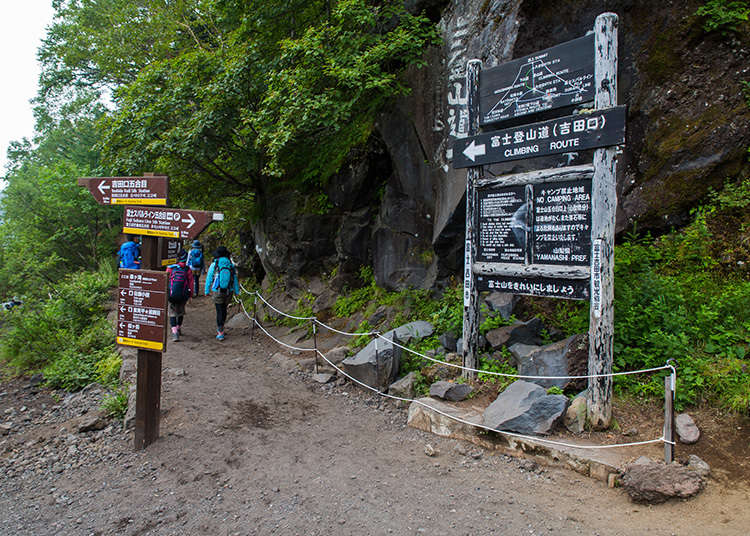
The most popular and most accessible trail is the Fuji Yoshida trail in the north, where the 5th station starts you at 2,305 meters above sea level. At the station you can find all sorts of restaurants and shops to prepare for your hike or to bring souvenirs home. The traditional ascent merits that hikers should start their climb in the late evening in order to arrive at the summit around 4:30 a.m. to 5:00 a.m. in order to admire the sunrise.
The trail from the 5th station to the 6th station is a relatively easy 30 minute hike and is a good warm up for the later parts of the climb. From the 6th station and onward, the real climb begins and the time between each station varies from 60 to 80 minutes depending on your speed. The path also introduces a mix of loose sand and small rocks, a steeper slope, and occasionally uneven stairs. Make sure to stay on the path as going outside of the path is extremely dangerous.
At the 7th station and onwards, the path will begin to zig-zag and the soil will begin to take on a reddish tint. By the time you reach the 8th station, you will be well into the clouds with a great view on sunny days. Make sure to take occasional breaks at the stations and you can reach the top in about 4 ~ 7 hours.
The trip down will take a zig-zagging path with loose pebbles and dirt. It takes an average of about 2 to 4 hours to descend from the top back to the 5th station, depending on your speed.
Climbing Fuji 2: The Subashiri Trail
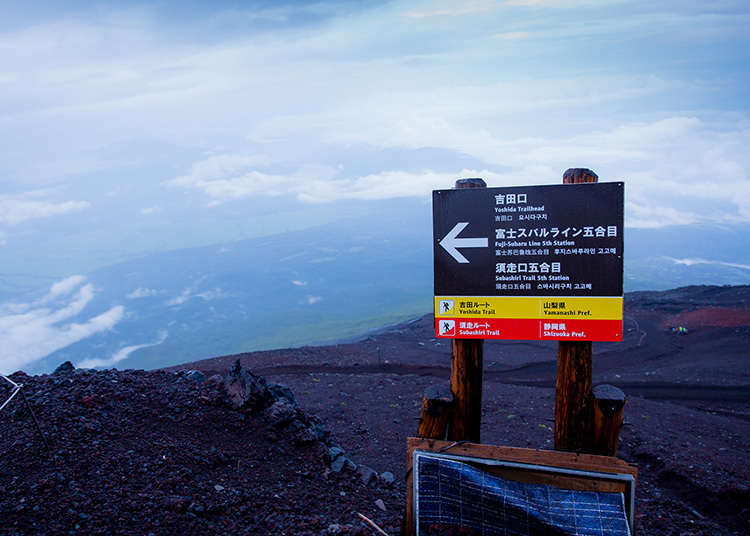
On the eastern side of the mountain, you can find the Subashiri trail. Not as crowded as the Fuji Yoshida trail, it offers a quieter and greener ascent. The forest zone extends up to high altitudes which will require head lamps if you decide to ascend late into the night.
At the 5th station, you can expect to find a few restrooms, a parking lot, a few small shops and restaurants. There are fewer huts on the way up, compared to the other trails, so this trail is more suited for climbers with experience.
At the old 8th station, the Subashiri trail meets the Fuji Yoshida trail to the summit. Expect to meet congestion towards the tail end of your ascent.
Climbing Fuji 3: The Gotemba Trail
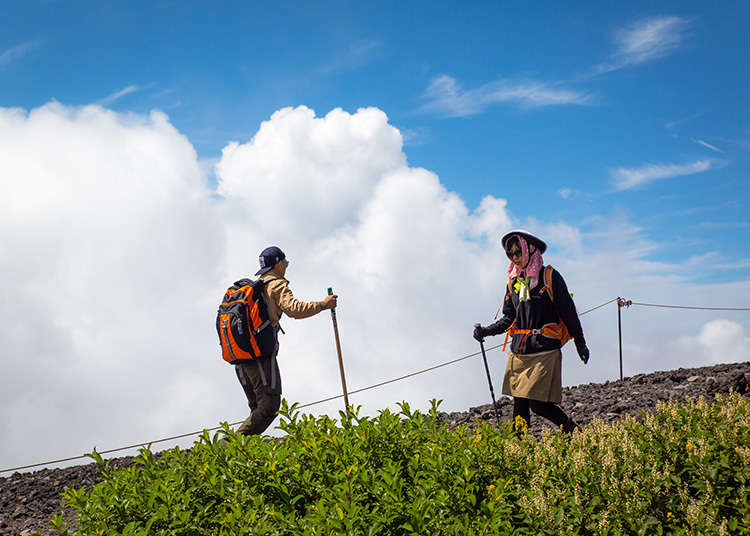
In the southeast, the Gotemba trail is deemed to be the most beautiful but also the most difficult path. Its 5th station stands at 1,440 meters and the climb takes an average of 8 hours with a steep slope.
This trail is best suited for good walkers that can cope with the altitude difference and the 11km ascend to the summit. There are also no huts and toilets until you reach the 7th station.
The best advantage is that it has the smallest number of climbers among the four trails and you can see the sunrise from anywhere on the trail.
Those that want to attempt this trail are advised to leave early with enough food and water.
Climbing Fuji 4: The Fuji-Nomiya Trail
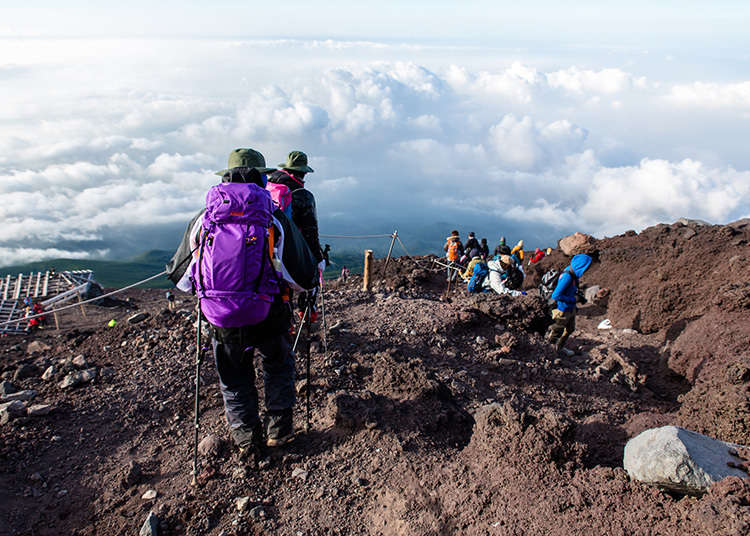
Easily accessible for hikers arriving from the Kansai area of Japan, Fuji-Nomiya's 5th station stands at 2,380 meters above sea level. The trail is the shortest of all the trails, however the slope is very steep with rocky terrain towards the top. It is advised to climb with caution as injuries can occur easily due to the loose terrain.
Weather on Mt. Fuji
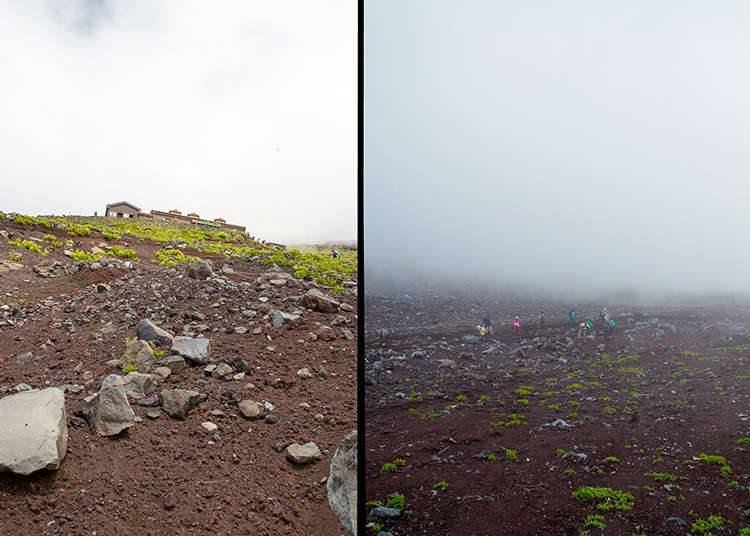
The weather on Mount Fuji is unpredictable and can change from bright sunshine to heavy rain very quickly. Thus, it is necessary to inquire about the expected weather before departure. Even during mid-summer, the temperature at the top of the mountain is between 5°C and 8°C. Furthermore, in addition to water and food that are needed for the ascent, a number of essential accessories and equipment should be prepared before beginning your climb.
Bring proper equipment
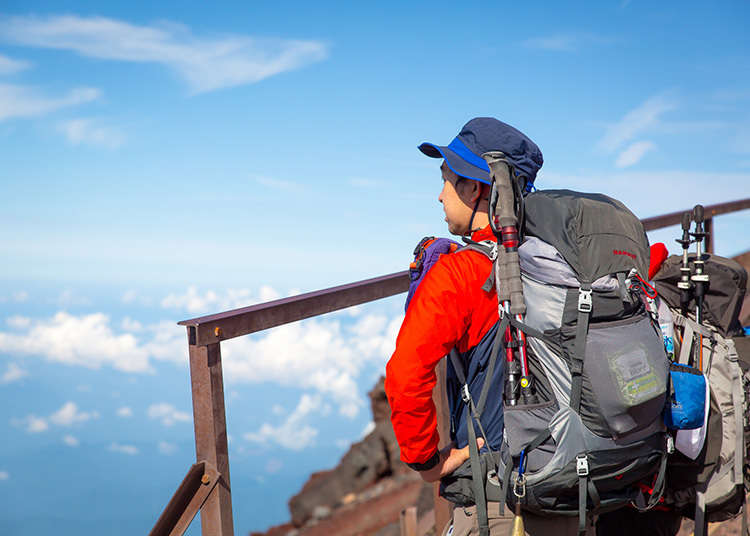
Whatever time you decide to start your climb, you will run into nightfall on the road and in this case, lamps and/or frontal flashlights are indispensable. Hiker sticks are also a great support. One or two, considering that the initial enthusiasm of the climb fades as you advance, and fatigue may take over if one is ill prepared. Don't forget also to bring a nice pair of climbing shoes, a knapsack, rain gear and cold-weather wear.
Climbing Mt. Fuji Off-Season

The official climbing season is set from July 1st to the end of August, when the huts are operating and special buses are running. It is not recommended to try to climb Mount Fuji during off-season. People often underestimate the severity of climbing conditions. As a standalone peak with no surrounding barriers, Mt. Fuji has horrendous winds, especially in the winter. Spring is the time for avalanches, which are common because of the lack of vegetation and melting snow. If you are an experienced winter outdoorsman with the appropriate equipment, you will need to get the authorization by submitting paperwork to the local police department.
Prepare in advance and Stay Safe

Although the climb allows children, it’s usually better to hire a babysitter before embarking on the adventure. Relatively easy and accessible to all, the ascent of Mount Fuji can sometimes prove to be a challenging exercise. Even with regular breaks, inevitably, small children can get tired fast.
With these things in mind and packing the appropriate gear, you are sure to have a safe and memorable hike on Japan's iconic mountain.
Access: Take the Fujikyu Bus heading towards the Fujisan Gogome station, from either Kawaguchiko (Fujikyu Line) or Mt. Fuji (Fujikyu Line) stations. The route takes about 1 hour and you can get off at the final stop.
Access to Kawaguchiko Station from Tokyo: Take the Fujikyu Line from Otsuki Station (JR Chuo Main Line) to Kawaguchiko Station. This route takes about 40 minutes by Express Train.
-

-
Address
Fujiyoshida-shi, Yamanashi, 403-0000
View Map -
Nearest Station
Gotemba Station (JR Gotemba Line)
-
Address
Fujiyoshida-shi, Yamanashi, 403-0000
*Prices and options mentioned are subject to change.
*Unless stated otherwise, all prices include tax.
Popular Tours & Activitiess
-

Strawberries, Style, and Tokyo’s Coolest Neighborhood: Winter Afternoon Tea in Kichijoji
by: Guest Contributor
-
Ad

(Opening in Jan 2026) 'THE SUMO LIVE RESTAURANT HIRAKUZA GINZA TOKYO!' 5 Exciting Ways to Experience the World of Sumo!
-

New in Ginza! Air BicCamera Ginza Opens with a Faster, More Convenient Shopping Experience
by: Guest Contributor
-
Ad

Complete Guide to Ueno's National Museum of Nature and Science, the Perfect Place to Visit on Rainy Days or With Children
-

Japan’s Shinkansen Is About to Change Travel in an Unexpected Way
by: Guest Contributor
-

This Winter, Godzilla Takes Over Haneda Airport
by: Guest Contributor
Inspiration for Accommodations
-

Enjoy Mt. Fuji from the Comfort of Your Room! Recommended Ryokan with Mt. Fuji View
-

Stay Near the Cherry Blossoms! Hotels for Cherry Blossom Viewing in Tokyo
-

Family-Friendly Hotels with Free Shuttle to Disneyland: Convenient Access for a Magical Stay
-

Top Ranked Hakone Hotels with Mt. Fuji View: Enjoy Stunning Scenery from Your Private Space
-

Convenient Tokyo Hotels with Airport Shuttle: Ideal for Families and Heavy Luggage
-

Stunning Tokyo Tower View Hotels: Enjoy Spectacular Scenery from Your Private Space
-

Convenient Asakusa Hotels with Kitchens: Ideal for Extended Family Visits
-

Experience Luxury: Hakone's 10 Best Five-Star Accommodations
-

Enjoy Mt. Fuji Autumn Leaves! Top Hotels Near the Popular Autumn Leaves Corridor
-

Experience Hakone Fall Foliage from Your Room with Stunning Views
-

Bicycling Tour of Tokyo: 3 Sightseeing Cycle Guides for Seeing Tokyo this Spring!
by: David McElhinney
-

16 Secrets About Mt. Fuji, the Symbol of Japan: Even Japanese People Don’t Know That?!
-

Healthcare in Japan for Tourists: What to Do When You Get Sick or Injured in Japan
-

32 Must-Do Things in Tokyo: Top Attractions for First-Time & Repeat Visitors
-

Kayak to an uninhabited island in the Seto Inland Sea, near Kagawa
-

10 Tokyo Places You Can Enjoy for Free!
- #best ramen tokyo
- #what to buy in ameyoko
- #what to bring to japan
- #new years in tokyo
- #best izakaya shinjuku
- #things to do tokyo
- #japanese nail trends
- #what to do in odaiba
- #onsen tattoo friendly tokyo
- #daiso
- #best sushi ginza
- #japanese convenience store snacks
- #best yakiniku shibuya
- #japanese fashion culture
- #best japanese soft drinks




















